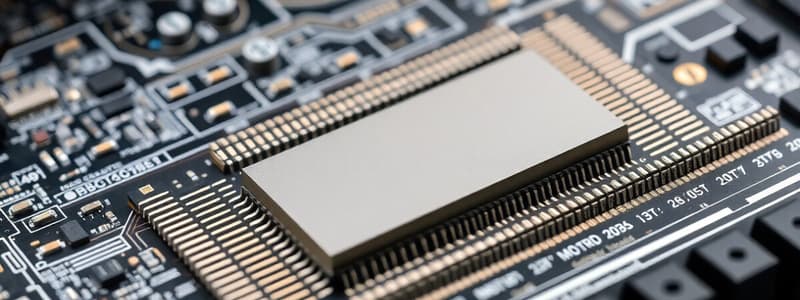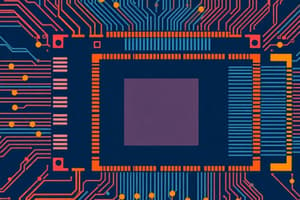Podcast
Questions and Answers
What is the primary reason for using cache memory in a computer system?
What is the primary reason for using cache memory in a computer system?
- To reduce the cost of dynamic memory
- To increase the speed of data processing (correct)
- To eliminate the need for main memory
- To provide storage for the operating system
What type of memory is primarily used in main memory systems?
What type of memory is primarily used in main memory systems?
- Dynamic memory (DRAM) (correct)
- Read-Only memory (ROM)
- Flash memory
- Static memory (SRAM)
Which cache level is accessed first by the CPU when looking for data?
Which cache level is accessed first by the CPU when looking for data?
- L2 Cache
- L1 Cache (correct)
- Main Memory
- L3 Cache
In modern processors, where is cache memory typically integrated?
In modern processors, where is cache memory typically integrated?
What is a significant drawback of using static memory (SRAM) compared to dynamic memory (DRAM)?
What is a significant drawback of using static memory (SRAM) compared to dynamic memory (DRAM)?
What was the first commercial computer developed in 1951?
What was the first commercial computer developed in 1951?
Which of the following integrated circuits was developed in 1958?
Which of the following integrated circuits was developed in 1958?
What was significant about the IBM System 360 introduced in the mid-1960s?
What was significant about the IBM System 360 introduced in the mid-1960s?
What was the first microprocessor released by Intel in 1971?
What was the first microprocessor released by Intel in 1971?
Which microprocessor is classified as an 8-bit processor?
Which microprocessor is classified as an 8-bit processor?
Which of the following processors was released after the 4004 and is a 16-bit microprocessor?
Which of the following processors was released after the 4004 and is a 16-bit microprocessor?
Which company developed the PDP-1, known for being the first to have a keyboard and mouse?
Which company developed the PDP-1, known for being the first to have a keyboard and mouse?
Which of the following microprocessors has a 32-bit architecture?
Which of the following microprocessors has a 32-bit architecture?
Who founded the company that developed the first microprocessor, the 4004?
Who founded the company that developed the first microprocessor, the 4004?
What is the role of the function units in a processor?
What is the role of the function units in a processor?
What is a significant risk associated with overclocking a processor?
What is a significant risk associated with overclocking a processor?
What is the recommended practice when it comes to overclocking?
What is the recommended practice when it comes to overclocking?
Which technology allows processors to fit millions of transistors in a small area?
Which technology allows processors to fit millions of transistors in a small area?
What limits the compatibility of processors with motherboards?
What limits the compatibility of processors with motherboards?
What can happen if cooling is inadequate during overclocking?
What can happen if cooling is inadequate during overclocking?
What speeds can contemporary processors typically operate at?
What speeds can contemporary processors typically operate at?
What does CISC architecture facilitate regarding microcode?
What does CISC architecture facilitate regarding microcode?
One of the disadvantages of CISC architecture includes which of the following?
One of the disadvantages of CISC architecture includes which of the following?
Which of the following statements regarding flag status in CISC is accurate?
Which of the following statements regarding flag status in CISC is accurate?
How did RISC architecture evolve in relation to CISC architecture?
How did RISC architecture evolve in relation to CISC architecture?
Which characteristic of CISC architecture directly impacts the speed of instruction execution?
Which characteristic of CISC architecture directly impacts the speed of instruction execution?
What is a feature of microprogramming in CISC architecture?
What is a feature of microprogramming in CISC architecture?
Which of the following best describes the dynamics of instruction execution in CISC?
Which of the following best describes the dynamics of instruction execution in CISC?
What advantage does CISC architecture have over RISC when it comes to programming?
What advantage does CISC architecture have over RISC when it comes to programming?
Which company or companies were pivotal in the development of RISC architecture?
Which company or companies were pivotal in the development of RISC architecture?
Which aspect of hardware implementation is associated with CISC?
Which aspect of hardware implementation is associated with CISC?
What is a characteristic of programs written for the Intel 80x86 architecture?
What is a characteristic of programs written for the Intel 80x86 architecture?
Which statement best describes the speed mismatch problem?
Which statement best describes the speed mismatch problem?
What distinguishes dynamic memory from static memory?
What distinguishes dynamic memory from static memory?
Which of the following is NOT a group into which memories are divided?
Which of the following is NOT a group into which memories are divided?
What technology do dynamic memories primarily rely on?
What technology do dynamic memories primarily rely on?
What happens to the logical states in dynamic memory during operation?
What happens to the logical states in dynamic memory during operation?
What was a characteristic of early microprocessors compared to memory?
What was a characteristic of early microprocessors compared to memory?
What is the chief benefit of separating commands and data in memory design?
What is the chief benefit of separating commands and data in memory design?
What role do additional instruction sets like SSE and 3D Now! play in processors?
What role do additional instruction sets like SSE and 3D Now! play in processors?
In terms of memory architecture, which statement is accurate?
In terms of memory architecture, which statement is accurate?
Flashcards
Execution Unit
Execution Unit
The part of a processor responsible for executing instructions, such as addition or conditional branching.
Function Units
Function Units
Specialized units within a processor that handle different types of instructions. For example, an Arithmetic/Logic Unit (ALU) handles arithmetic operations, while a Floating Point Unit (FPU) handles fractional numbers.
Overclocking
Overclocking
The process of increasing a processor's clock speed beyond its factory settings, potentially leading to increased performance but also risks like overheating.
Bus Speed
Bus Speed
Signup and view all the flashcards
Slot Socket
Slot Socket
Signup and view all the flashcards
Socket Socket
Socket Socket
Signup and view all the flashcards
Micron Technology
Micron Technology
Signup and view all the flashcards
RISC Architecture
RISC Architecture
Signup and view all the flashcards
CISC Architecture
CISC Architecture
Signup and view all the flashcards
Decoding
Decoding
Signup and view all the flashcards
Processable Codes
Processable Codes
Signup and view all the flashcards
Microprogramming
Microprogramming
Signup and view all the flashcards
Backward Compatibility
Backward Compatibility
Signup and view all the flashcards
Clock Cycles
Clock Cycles
Signup and view all the flashcards
Flag Bits
Flag Bits
Signup and view all the flashcards
Memory Speed
Memory Speed
Signup and view all the flashcards
Processor Architecture Design
Processor Architecture Design
Signup and view all the flashcards
UNIVAC 1
UNIVAC 1
Signup and view all the flashcards
Integrated Circuits
Integrated Circuits
Signup and view all the flashcards
Magnetic Core Cell Memories
Magnetic Core Cell Memories
Signup and view all the flashcards
IBM System 360
IBM System 360
Signup and view all the flashcards
PDP-1
PDP-1
Signup and view all the flashcards
Microprocessor
Microprocessor
Signup and view all the flashcards
Intel 4004
Intel 4004
Signup and view all the flashcards
32-Bit Processor
32-Bit Processor
Signup and view all the flashcards
64-Bit Processor
64-Bit Processor
Signup and view all the flashcards
Cache
Cache
Signup and view all the flashcards
Main Memory
Main Memory
Signup and view all the flashcards
SRAM (Static RAM)
SRAM (Static RAM)
Signup and view all the flashcards
DRAM (Dynamic RAM)
DRAM (Dynamic RAM)
Signup and view all the flashcards
Cache Levels (L1, L2, L3)
Cache Levels (L1, L2, L3)
Signup and view all the flashcards
Intel 80x86 Architecture
Intel 80x86 Architecture
Signup and view all the flashcards
Instruction Set Extensions (SSE, 3D Now!)
Instruction Set Extensions (SSE, 3D Now!)
Signup and view all the flashcards
Dynamic RAM (DRAM)
Dynamic RAM (DRAM)
Signup and view all the flashcards
Static RAM (SRAM)
Static RAM (SRAM)
Signup and view all the flashcards
Speed Mismatch
Speed Mismatch
Signup and view all the flashcards
Cache System
Cache System
Signup and view all the flashcards
Memory
Memory
Signup and view all the flashcards
Study Notes
Introduction to Information Technologies (WICT 101)
- This course is an introduction to information technologies
- It is taught by Dr. Murat ARSLAN
- Contact email is [email protected]
What is a Computer?
- A computer is an electronic machine that performs logical and arithmetic operations
- It receives data from the user, processes data, stores results, and accesses information
- It's fast, doesn't get tired, and can be programmed
- Computers do not function independently. They need instructions (software) to perform actions.
Computer Components
- Input: Data enters the computer (e.g., keyboard, mouse, microphone)
- Processing: Data is manipulated according to instructions (e.g., CPU)
- Memory: Data is stored (e.g., RAM, hard drive)
- Output: Results are presented (e.g., monitor, printer, speakers)
Types of Computers
- Macro Computers (Mainframe): Large, powerful computers used by large organizations (e.g., data processing centers, universities)
- Mini Computers: Mid-sized computers used by medium-sized businesses
- Micro Computers (Personal Computers - PCs): Designed for a single user (e.g., desktops, laptops)
Networks
- Networks connect computers to share data, hardware, and software
- This reduces costs and speeds up work
- Network types include LAN (Local Area Network), WAN (Wide Area Network), Intranet, and Internet
- Each user has a username and password for security, changed as needed
Computer Software
- Free to Use Software (Public Domain): Open-source software anyone can use
- Shareware: Copyrighted software for trial use, with a purchase necessary for permanent use
- Operating System: Software that manages computer resources, facilitating interactions between the user and the computer (e.g., Windows, macOS, Linux)
- Disk Operating System (DOS): A type of operating system (e.g., Windows 3.1, 95, 98, DOS, macOS, UNIX, LINUX)
Useful Software and Programs
- Device drivers: Programs that operate hardware devices
- Programming languages: Instructions for computers (e.g., C, Pascal, Java)
- Application programs: Specialized software for specific tasks (e.g., word processors, spreadsheets, games)
- Commercial software: Software for business purposes (e.g., accounting, forecasting)
- Educational/Application software: Programs for learning and performing tasks (e.g., educational software, simulations)
- Multimedia software: Integrates sound, video, animation, and images (e.g., multimedia encyclopedias)
Computer Files
- File names consist of a name and an extension (e.g., document.doc)
- Working files (.exe, .com) run without additional programs
- Source files need translation before use
- Data files (.doc) can be changed or printed
Computer and Health
- Appropriate posture and distance from the screen are important while using computers
- Regular breaks and eye exercises are important for computer users.
Basic Concepts of Computers
- Analog Computers: Use continuous signals (e.g., thermometer). They are less common now.
- Digital Computers: Use discrete signals represented as numbers (e.g., 0 and 1). They are very common.
- Hybrid Computers: Combine analog and digital features.
CPU (Central Processing Unit)
- Brains of the computer
- Performs operations and sends results
- Measured by MHz or GHz, higher numbers mean faster speed
- Consists of transistors and circuits
- Essential for performing calculations
Overclocking
- Technically increasing the speed of a processor
- Risky, if not done properly
Caches
- A special type of memory inside the processor that stores frequently used data
- Increases processor speed
Hyperthreading
- Allows a single processor to act Like multiple processors
- Increases performance
Computer History
- Early calculating devices (e.g., Abacus, Pascaline, Difference Engine)
- Development of electronic computers and components
- Progression of computer generations (Mechanical, Electronic, Microprocessor)
Computer Architecture
- CISC (Complex Instruction Set Computer): Uses complex instructions, which are more helpful for tasks but consume more system resources
- RISC (Reduced Instruction Set Computer): Uses simple instructions, which do not consume so many resources
Studying That Suits You
Use AI to generate personalized quizzes and flashcards to suit your learning preferences.




